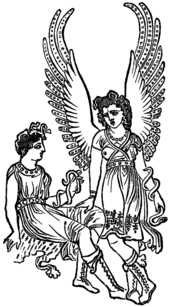
| Greek deities series |
|---|
| Chthonic deities |
In Greek mythology the Erinýes (Ἐρινύες, pl. of Ἐρινύς, Erinýs; literally "the angry ones") or Eumenídes (Εὐμενίδες, pl. of Εὐμενίς; literally "the gracious ones" but also translated as "Kind-hearted Ones" or "Kindly Ones") or Furies or Dirae in Roman mythology were female chthonic deities of vengeance or supernatural personifications of the anger of the dead. A formulaic oath in the Iliad invokes them as "those who beneath the earth punish whosoever has sworn a false oath".[1] Burkert suggests they are "an embodiment of the act of self-cursing contained in the oath".[2]
When the mighty Titan Cronus castrated his father Uranus and threw his genitalia into the sea, the Erinyes emerged from the drops of blood, while Aphrodite was born from the crests of seafoam. According to a variant account, they issued from an even more primordial level—from Nyx, "Night". Their number is usually left indeterminate. Virgil, probably working from an Alexandrian source, recognized three: Alecto ("unceasing", who appeared in Virgil's Aeneid), Megaera ("grudging"), and Tisiphone ("avenging murder"). Dante followed Virgil in depicting the same three-charactered triptych of Erinyes; in Canto IX of the Inferno they confront the poets at the gates of the city of Dis. The heads of the Erinyes were wreathed with serpents (compare Gorgon) and their eyes dripped with blood, rendering their appearance rather horrific. Other depictions show them with the wings of a bat or bird and the body of a dog.
In Aeschylus's "Eumenides", the Erinyes chase Orestes to avenge Clytemnestra, his mother. Orestes killed Clytemnestra to avenge the murder of his father, Agamemnon. The Erinyes chase Orestes to Athens where Athena then intervenes. She and the Athenians judge whether Orestes deserves the wrath of Erinyes and rule in favor of Orestes. Athena, in order to appease the Erinyes, gives them the love of Athens and renames them the Eumenides. The Eumenides are given red robes to replace the black robes they wore for most of the play, drawing an end to the red color scheme that is evident throughout the play.
In the 2010 video game God of War: Ghost of Sparta, Erinyes (spelled Erinys in the game) is the daughter of Thanatos, God of Death, and encountered by the main character Kratos as a boss and is killed by Kratos. Erinys is depicted as one being but with two voices (heard simultaneously) and refers to itself as "we". Erinys can also transform into a giant eagle.